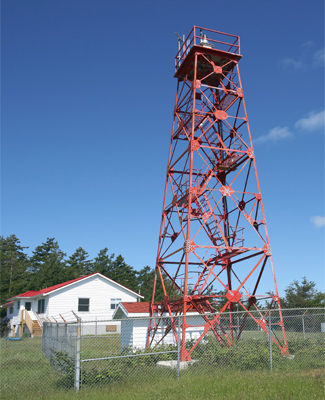East Point Lighthouse (Saturna Island)
Heritage Lighthouse
Saturna Island, British Columbia

General view
(© Kraig Anderson - lighthousefriends.com)
Address :
Tumbo Channel Road, Saturna Island, British Columbia
Recognition Statute:
Heritage Lighthouse Protection Act (S.C. 2008, c 16)
Designation Date:
2013-05-23
Dates:
-
1949 to 1949
(Construction)
-
1888 to 1888
(Established)
Other Name(s):
-
East Point Lighthouse (Saturna Island)
(Designation Name)
Description of Historic Place
Built in 1949, the East Point Lighthouse (Saturna Island) is a coastal light located on the eastern tip of Saturna Island, in the southern Gulf Islands of British Columbia. The lightstation sits on approximately seven acres of land which is now within the Gulf Islands National Park Reserve. The utilitarian steel skeleton tower was erected to replace the original 1888 combined lighthouse and dwelling.
There are several structures on the site, including one related building that contributes to the heritage character of the lighthouse: (1) the 1938 former fog alarm building, which has been rehabilitated to welcome guests to East Point and inform them of the island’s multi-faceted history.
Heritage Value
The East Point Lighthouse (Saturna Island) is a heritage lighthouse because of its historical, architectural, and community values.
Historical values
The East Point Lighthouse (Saturna Island) was established following the wreck of a ship carrying coal from Nanaimo to San Francisco, and was the product of lobbying by the maritime community, local members of parliament, and trade interests in the region. The establishment of the lightstation on the site excellently illustrates the results of public demands for improved aids to navigation in British Columbia during the 1880s. East Point is also noted as a popular spot for liquor smuggling during the United States’ prohibition era as well as for the nearby capture of the Orca whale, Moby Doll, in 1964.
East Point was a vital addition to the aids to navigation system in British Columbia, serving the intricate shipping channel between the Juan de Fuca and Georgia straits. Its early lighthouse keepers formed part of the original community of European settlers on Saturna and are considered to be among the island’s pioneering families. In connecting families and helping to develop a sense of community, the lightstation is a very good illustration of the development of the island itself.
Architectural values
The East Point Lighthouse (Saturna Island) is a 14-metre square tapered steel skeleton tower with six platforms. Designed primarily for function rather than decorative purposes, it is a very good example of its type. It is one of only a few skeleton towers installed at a major lightstation in British Columbia.
Skeleton lighthouse towers are cheaper and easier to build, adaptable to a variety of heights, and more likely to survive extreme weather conditions (especially wind). The East Point Lighthouse is a very good example of a skeleton lighthouse tower, consisting of bare structural “bones” without infill. It is also one of the first places on the West Coast where an airport beacon light was used for marine purposes.
Community values
Acquired as part of the Gulf Islands National Park Reserve in part because of its associations with the cultural heritage of the region as well as the beauty and appeal of the site and its associated viewscapes, the East Point Lighthouse (Saturna Island) reinforces the character of the surrounding area.
The East Point Lighthouse (Saturna Island) has been widely visited by Islanders and tourists and has been a popular destination for whale watching and heritage tourism, with visitation heavily concentrated in the summer season. As a whole, the lightstation, including the former fog alarm building, is a symbol of the region, as evidenced by its depiction in local, provincial, and national publications. The continuity of the site as a lightstation for more than 124 years is part of Island life and lore.
Related buildings
One related building, the former fog alarm building (a cherished community symbol and one of the most photographed buildings in the Gulf Islands), contributes directly to the lighthouse’s heritage character.
Character-Defining Elements
The following character-defining elements of the East Point Lighthouse (Saturna Island) should be respected:
— its intact, as-built structural form, height, profile, and proportions, with six integrated platforms and connecting flights of stairs;
— its steel structure fabricated of sectional components;
— its uppermost square platform on which rests a lighting apparatus;
— its gallery railing, including its respective designed form and proportions;
— its red colour scheme;
— its visual prominence in relationship to the water and landscape.
The following character-defining elements of the related building should be respected:
— its built form, profile, proportions, cladding, doors, windows, and traditional building materials;
— its traditional red and white exterior colour scheme;
— its contextual relationship to the lighthouse within an historic lightstation setting.